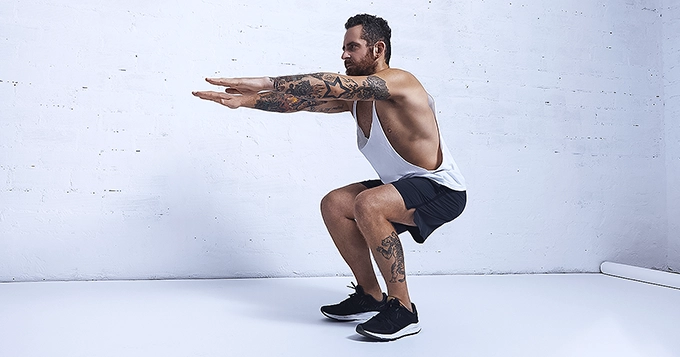What is Aerobics?
Aerobic exercise is a workout that involves big muscle groups in your body. It follows a steady, repetitive rhythm. You have control over how hard you push yourself in this type of exercise by adjusting the intensity.
These exercises make your heart beat faster and increase the amount of oxygen your body uses. “Aerobic” basically means “with oxygen.” During aerobic workouts, your breathing regulates how much oxygen gets to your muscles, helping in energy burn and movement.
Samples of Aerobic Exercise (No Equipment):
- Frog jumps
- Burpees
- Mountain climbers
- Squat jumps
- Side-to-side jumping lunges
- Prisoner squat jumps
- Long jumps
- Plyo jacks
- Plyo lunges
- Jogging with high knees
Samples of Aerobic Exercise (With Equipment)
- Jumping rope
- Stationary bike
- Elliptical
- Stair machine
- Treadmill
Benefits of Aerobics Workout
-
Regulates weight
In a research study, individuals who were overweight maintained their regular diets but participated in exercise sessions aimed at burning 400 to 600 calories five times a week for a duration of 10 months.
The findings indicated substantial weight loss, ranging from 4.3 to 5.7% of their initial weights for both men and women. The majority of participants chose to walk or jog on treadmills. If a treadmill is not available, consider incorporating brisk walks or jogs into your routine. Depending on your body weight and pace, covering up to 4 miles may be necessary to burn 400 to 600 calories.
Combining cutting your calorie intake and aerobic exercise can also reduce the amount of exercise needed to achieve the same weight loss.
-
Regulates blood sugar level
Moving your body regularly is great for keeping insulin levels in check and reducing blood sugar, while also helping you maintain a healthy weight. A study on people with type 2 diabetes discovered that any type of activity, whether it’s aerobic (like jogging or dancing) or anaerobic (like weightlifting), can have these positive effects.
-
Lowers blood pressure
Aerobic exercise helps lower blood pressure in a few ways. It promotes the dilation of blood vessels, facilitating smoother blood flow and easing the workload on your heart. These changes, over time, lead to lower resting blood pressure levels.
-
Improves heart health
The American Heart Association and many doctors recommend aerobic exercise for those with or at risk of heart disease. This type of exercise strengthens the heart, making it pump blood more efficiently. Cardiovascular exercise can also lower blood pressure, clear arteries, and improve cholesterol levels. For blood pressure and cholesterol benefits, target 40 minutes of moderate to vigorous aerobic exercise 3 to 4 times a week.
-
Aids sleep
If you’re having difficulty sleeping, consider incorporating cardiovascular exercise into your daytime routine.
A study focusing on individuals with chronic sleep problems found that a consistent exercise program, combined with education on sleep hygiene, proved to be an effective treatment for insomnia. After engaging in aerobic activity for 16 weeks, participants reported better sleep quality and duration, along with enhancements in daytime wakefulness and vitality.
It’s advisable to complete your workout at least two hours before bedtime, as exercising too close to sleep may hinder your ability to fall asleep easily.
-
Reduces asthma symptoms
Doing aerobic exercise can reduce how often and how severe asthma attacks are for people with this issue. But before you start a new workout routine, it’s important to talk with your doctor, especially if you have asthma. They can suggest specific activities or precautions to make sure you stay safe while exercising.
-
Reduces chronic pain
If you’re dealing with chronic back pain, engaging in aerobic exercise, particularly low-impact options like swimming or aqua aerobics, could be beneficial in restoring muscle function and endurance. And as mentioned earlier, regular exercise aids in weight loss, potentially easing your back pain even more.
-
Reduces risk of falls
Exercise can significantly reduce the risk of falls, especially for individuals over 65.
A study involving women aged 72 to 87 found that engaging in aerobic dance three times a week for an hour enhanced balance and agility. The dance sessions included movements like squats and leg balances.
Upon completion of the research, the women showed improved performance in tasks such as standing on one leg with eyes closed, better grip strength, and enhanced reach – essential factors in preventing falls.
Before starting a new exercise routine, consult your doctor and progress gradually. Group classes, with proper instruction, can provide a safe and monitored environment to exercise and reduce the risk of injury.
-
Boosts mood
Getting your body moving can have a positive impact on your mood. In a study involving individuals with depression, participants walked on a treadmill in 30-minute intervals for 10 days. After this short period, they reported a significant reduction in depressive symptoms. This suggests that even brief exercise sessions can have a notable effect on mood. You don’t have to wait long to see improvements – the study found that even a single exercise session may be sufficient to give you a mood boost.
Risks of Aerobic Exercises
Aerobic exercises can put you at risk of the following:
- Sprains and strains
- Bone fracture
- Joint pain
- Muscle cramps
- Pain or soreness
Prevent injury when doing Aero Workout
Use these tips to prevent injury:
- Consult your healthcare provider before initiating regular physical activity.
- Learn how to safely use exercise equipment.
- Employ correct techniques and adhere to exercise instructions.
- Wear appropriate gear or clothing.
- Stay vigilant about your surroundings.
- Engage in proper warm-up and stretching routines.










